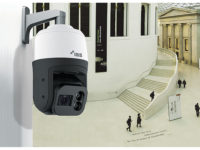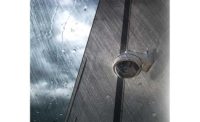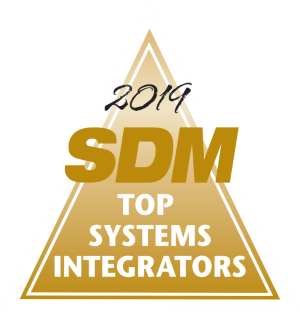VIDEO SURVEILLANCE
Megapixel Security Camera Features: New & Improved
Upgrades to features such as noise reduction and motion detection make today’s security megapixel cameras better than ever.

The latest moving cameras are equipped with deep learning-based intelligent tracking to classify and track objects even while the camera is in motion. // IMAGE COURTESY OF BOSCH SECURITY & SAFETY SYSTEMS
When it comes to megapixel counts in security video surveillance cameras, it’s important to resist the marketing claims that “more is always better,” notes Aaron Saks, senior technical marketing and training manager, Hanwha Vision America, Teaneck, N.J. “Over the past couple of years, megapixel totals have been increasing but the focus should be on having better, or more effective, megapixels and not just simply more.”
Number of megapixels is only one feature to consider when choosing the correct camera. Recent improvements in megapixel cameras include sensor size, low-light performance, noise reduction, and other capabilities like built-in artificial intelligence (AI). Here is an overview of some new functions and features that make modern megapixel cameras the most advanced of their kind.

Bigger Sensors for Better Video Surveillance Images
While most of the camera features that make headlines these days are software-based, hardware enhancements are also happening. Manufacturers are implementing larger sensors in many megapixel models.
“Recent improvements in megapixel cameras include sensor size, low-light performance, noise reduction, and other capabilities like built-in artificial intelligence (AI).”
Steven Jussaume, solutions engineer at Axis Communications in Chelmsford, Mass., speaks to the benefits of larger sensors. “This past year we’ve released a number of new cameras with increased sensor size to let more light and information in for processing. By utilizing ½-inch image sensors in some of our new 4K products we are able to achieve significant improvements in image quality, low-light performance and overall image usability. This combination of hardware, paired with our latest generation of chipset, now allows us to process that image with advanced AI algorithms.”
Hanwha has also increased the size of their sensors. “It’s important to look at the camera’s sensor size and the low light spec,” Saks says. “As the sensor gets bigger, more light can hit it and that means the pixels can be larger and give you more detail.”
Kambiz Haghighi, director of video hardware, video security and access control, Motorola Solutions, Chicago, adds, “Cameras with the latest sensors enable us to deliver better low light performance, including reducing motion blur by using less shutter time and more ISO as well as increasing the visibility of the dark regions of the image in high dynamic range scenes by incorporating more aggressive local tone mapping.”
Noise Reduction for Improved Low-Light Camera Performance
Images captured in low-light environments are clearer than ever not only due to larger sensors but also advancements in AI and noise reduction.

“Combining these technologies provides more detail due to lower noise and boosts monochrome sensitivity to the next level to offer improved performance in extreme low-light scenes,” says Chris Johnston, regional marketing manager – moving cameras for Bosch Security and Safety Systems in Fairport, N.Y.
i-PRO is using AI-based object detection to help reduce noise. “In the past year, we have continued to tweak the image processing on our AI-based cameras to further reduce noise around detected objects, particularly in low light conditions,” remarks Takao “Tiger” Koishi, strategic planning, i-PRO Americas Inc., Houston. “AI-based object detection informs our image processing system as to which pixels represent a known object that is in motion, such as a vehicle or person. In this way, the camera is able to reduce noise and ghosting around a moving object without impacting static objects and the image background.”
Hanwha Vision has also introduced AI-enabled noise reduction. “This and shutter speed optimization can determine lighting conditions within a scene and accurately detect people, vehicles, and fast-moving objects, then optimize all that simultaneously while still being able to perform functions like WDR,” Saks explains. Typically, there has been a trade-off between higher megapixels or covering a wide area. Hanwha’s newer cameras, Saks says, offer both: “Wide area coverage with high pixel detail and great low-light performance.”
Haghighi explains, “For both Pelco and Avigilon cameras, we are leveraging the increase in performance of the latest System-on-Chip (SoC) processors. With new algorithms, our new generation of cameras further reduces noise in low light through temporal noise filter optimizations for motion detection and a balanced approach of spatial noise reduction of textures versus noise. With every generation, the quality of the video is improving for human viewing and AI interpretation.”

Precise Motion Detection for More Effective Video Surveillance
The days of motion detection cameras sending false alarms about wind, moving trees, and animals are over — and if this is still a problem for you, you are using what Matt Mulham, marketing manager, Speco Technologies, Amityville, N.Y., politely calls “a legacy method of alerting the user to an event.
“These events are largely irrelevant to the user, as they would most likely prefer to be alerted to things like human and vehicle movement,” he continues. “Now, with our powerful advanced analytics, these pesky (and pricey) false alarms will no longer trigger an event, freeing up your system to alert you only to the motion you care about.”
In addition to capturing detailed images of moving objects, the need to track objects of interest as they move throughout a camera field of view is also important. “A moving camera equipped with deep learning based intelligent tracking can detect, classify, and track objects with precise detail while the camera is panning, tilting, or zooming, regardless of the state of the object — moving or stationary,” Johnson comments. “Robust algorithms based on artificial neural networks are trained to ignore potential disruptions caused by vehicle headlights or shadows, extreme weather, and sun reflections. As a result, AI-based intelligent tracking makes it possible for the camera to automatically follow persons or vehicles in traffic or city scenes by panning, tilting, and zooming to follow an object of interest and keep it prominently in the field of view.”

Stitched Images for Seamless Coverage
Specialty cameras that combine multiple image sensors provide users the ability to combine, or “stitch” views from multiple cameras to create one single view. These are a favorite for cost-effective, broad coverage. “We have a 180-deg. panoramic camera that can capture an entire side of a building, an entire warehouse floor, or even a parking lot, with one single camera install,” Mulham illustrates. “This feature allows you to view your footage on one channel in your recorder, freeing up additional channels for other camera installations.”
One progression in stitching technology is horizon straightening algorithms. “Axis has a four lens, 7 megapixel camera with an algorithm that provides a more natural look to a multi-sensor camera with a stitched image,” Jussaume says. “In addition, this allows for more effective AI based analytics across the entire 180-degree image.”
Continual development of cutting-edge camera features and functions that make video surveillance more efficient is one area where “more is always better.” More effective megapixels mean better performance, clearer and more detailed images, and more bang for your buck. More importantly, these allow for more proactive safety and security measures that are ushering video surveillance into a new era.
Looking for a reprint of this article?
From high-res PDFs to custom plaques, order your copy today!








